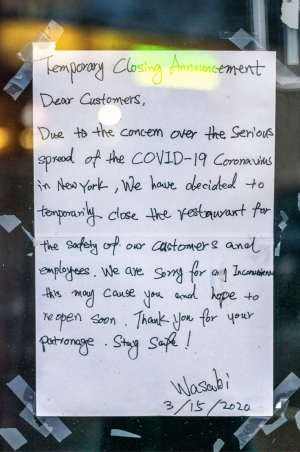Cuomo Called All the Shots — and Failed
NEW YORK NATIONAL GUARD VIA FLICKR
Gov. Cuomo and members of The New York National Guard attend a press conference at the Jacob K. Javits Convention Center in March 2020. The site was designated as a field hospital, but it was not filled to capacity and closed after a little over a month in operation.
November 11, 2020
 As states around the nation grappled with the COVID-19 crisis, Gov. Andrew Cuomo called all the shots in New York. He failed every step of the way.
As states around the nation grappled with the COVID-19 crisis, Gov. Andrew Cuomo called all the shots in New York. He failed every step of the way.
From the first confirmed COVID-19 case in the state to the present situation, Cuomo, Fordham College at Rose Hill ’79, has utterly failed to deliver a safe and equitable response to the coronavirus pandemic for all New Yorkers. An analysis of Cuomo’s pandemic response, divorced from the glossy and romanticized version that the media presents, reveals a man who has continuously made the wrong decisions at every turn.
Right after we all packed our bags and were ushered off campus, I wrote an article praising New York’s response to the impending pandemic, including the leadership of both Cuomo and New York City Mayor Bill de Blasio.
It appeared that both leaders were genuinely concerned about the well-being of their constituents. As time went on, it became clear that I was wrong.
At the time, I believed that the state and city were acting quickly in response to the viral trends, and it appeared that both leaders were genuinely concerned about the well-being of their constituents. As time went on, it became clear that I was wrong.
Cuomo declared New York state on “PAUSE,” short for Policies that Assure Uniform Safety for Everyone, on March 20. But the coronavirus was ravaging downstate well before the state was shut down. By March 20, there were over 8,300 cases throughout the state, most of which were in Westchester and Nassau counties and New York City. According to anonymous sources and administration insiders, Cuomo preferred a gradual shutdown, not wanting to cause mayhem. De Blasio, on the other hand, was ready to declare a stay-at-home order before Cuomo informed him that he had no such authority to do so.
And therein lies one major problem with Cuomo’s pandemic response: Many of his actions were not based on rational grounds. They were simply done to “put de Blasio in his place.” Look, I’m no de Blasio fan, either, but is a pandemic really the time to pull out the legal books and parse hairs over who has control over what in the city?
Cuomo’s antipathy for a quarantine of the tri-state area had disastrous consequences. According to The New York Times, New York City travelers seeded outbreaks across the country.
Take, for instance, the closing of New York City’s public school system. In April, after schools had already been closed for a month and officials realized that their earlier plan of reopening them to finish the academic year was practically impossible, de Blasio sent Cuomo a text message informing him that he decided to keep the schools closed. Mere hours later, Cuomo went to the podium insisting that he and only he could make that decision. This insistence from Cuomo came even as both men realized that there was no question de Blasio was right and that the schools wouldn’t reopen until September. Consider Cuomo’s action a pure power flex.
Despite Cuomo’s claim that President Trump downplayed the virus threat in February and March, he did so too, potentially to a greater extent. On March 10, when the state reported 173 cases, Cuomo said to the press, “As the number of positive cases rises, I am urging all New Yorkers to remember the bottom line: We talk about all this stuff to keep the public informed — not to incite fear — and if you are not a member of the vulnerable population, then there is no reason for excess anxiety.” At one point, he even stated that “the seasonal flu was a greater worry.” By the time that New York finally shut down, researchers at Northeastern University estimate that 10,700 people were already infected in the city.
While coronavirus ravaged the state and the Centers for Disease Control and Prevention recommended that all New York travelers quarantine for 14 days, Cuomo and the state’s health commissioner, Howard Zucker, shrugged off this suggestion. Magically, that view changed once New York had flattened the curve and was trying to fend off a new spike of its own.
Cuomo’s antipathy for a quarantine of the tri-state area had disastrous consequences. According to The New York Times, New York City travelers seeded outbreaks across the country. Obviously, the virus would have reached these places eventually, as it has in nearly every corner of the globe, but the inability of state leaders to so much as recommend that their own residents think of the well-being of the citizens of the states to which they fled is disappointing.
As horrible as that was, it wasn’t even Cuomo’s biggest mistake. On March 25, the state’s health department ordered that coronavirus patients be readmitted to their nursing homes if they were previously at a hospital; nursing homes were barred from testing readmitted residents. New York only counts deaths of nursing home residents when those deaths occurred at the physical home, unlike many other states that include hospitalized deaths, so there is no accurate count of how many people this policy killed. Conservatively, it resulted in the deaths of over 6,500 elderly people in the state. Including deaths at hospitals, that number balloons to more than 11,000.
There is no excuse for allowing that to happen. The entire country watched in shock and horror as death and devastation tore through unprepared and overwhelmed nursing homes in Washington state in February and early March. That is why other governors, such as Ron DeSantis of Florida, specifically banned COVID-19-positive nursing home residents from returning from the hospital prior to testing negative.
We now know that the Greater New York Hospital Association, a powerful lobbying group with a history of donating massive sums of money to Cuomo’s gubernatorial campaigns, had a hand in this nursing home policy, which is incredibly disturbing. They believed their hospitals would be overwhelmed, despite the fact that field hospitals constructed at the Javits Center and other locations were never even filled close to capacity.
Let’s remember, we have been living with COVID-19 in the United States for approximately 10 months now. While there are a handful of states with many more cases than New York, none have even come close to the Empire State’s death toll in terms of both sheer numbers and per capita fatalities. The idea that this state should be lauded for its handling of the virus is insane, considering the proportion of deaths here is higher than most countries, even those that had been plagued by the virus for longer than the United States.
We may never know the true toll of these horrendous coronavirus policies in New York, considering that many in the media idolize the state as the gold standard in its handling of the crisis. But despite the gleaming coverage that Cuomo has received, he has failed to protect not only the health and safety of New Yorkers but of all Americans. This is a man motivated by egoism and power. Democrats claimed Trump was insane when he said that he could shoot someone on Fifth Avenue and not lose voters, but evidently Cuomo can kill thousands and gain some more.
Now, as the nationwide crisis rages on, Cuomo has written a book laying out his ostensible successes in leading New York through the pandemic. You don’t “call it a win at half time,” as he suggested, but evidently publishing a book was in order. On CBS, Cuomo said that his book’s purpose was to “learn the lesson from the first half of the game and play a better second half,” yet the narrative arc of the story ends on June 19 (his final daily press briefing). Everything thereafter is called “The Aftermath.”
We are in the aftermath — not of success, but of failure.

















Christina Nakraseive • Nov 12, 2020 at 8:55 am
I am a retired RN, a senior citizen and a lifelong NYS resident. As a belt and suspenders type, I made my last Metro North and subway trips during the last week of February, realizing that the few announced cases of Covid were most likely the tip of the iceberg. I monitored the news and began my mask and goggles shopping trips and curtailed choir rehearsals and Mass attendance weeks in advance of government advice. My take on Governor Cuomo’s management of the pandemic is positive. It was a totally novel virus, minimized by the federal government. Trump got it right during is brief stint as a wartime president fighting the “invisible enemy.” Managing this pandemic was greatly hindered by lack of knowledge, lack of supplies and the fog of war. I don’t think that it is helpful or enlightening to “Monday morning quarterback” Governor Cuomo’s response to this pandemic. I found his plan methodical, consistent with science and reassuring. Here’s wishing Mr. Bernabei an opportunity to attend one of Governor Cuomo’s press briefings so that he can distinguish himself and win a job at the New York Post after graduation. I am FC class of 1975..